BSBADM506 Diploma: Business Document Design and Development
VerifiedAdded on 2023/01/16
|11
|4027
|64
Homework Assignment
AI Summary
This document presents the solutions for the BSBADM506 assessment, focusing on managing business document design and development at Canterbury Technical Institute. The assignment comprises short answer questions covering various aspects of document creation, including software proficiency, primary and secondary research methodologies, qualitative and quantitative data analysis, macro utilization, file naming conventions, legislative requirements for handling personal information, and the application of style guides. The solutions demonstrate an understanding of these concepts, offering examples and explanations to address each question effectively. The candidate demonstrates competency in identifying appropriate software for document creation, differentiating between research methods and data types, explaining the use and testing of macros, understanding file naming conventions, outlining relevant legislation, and defining the purpose and application of style guides within a business context.
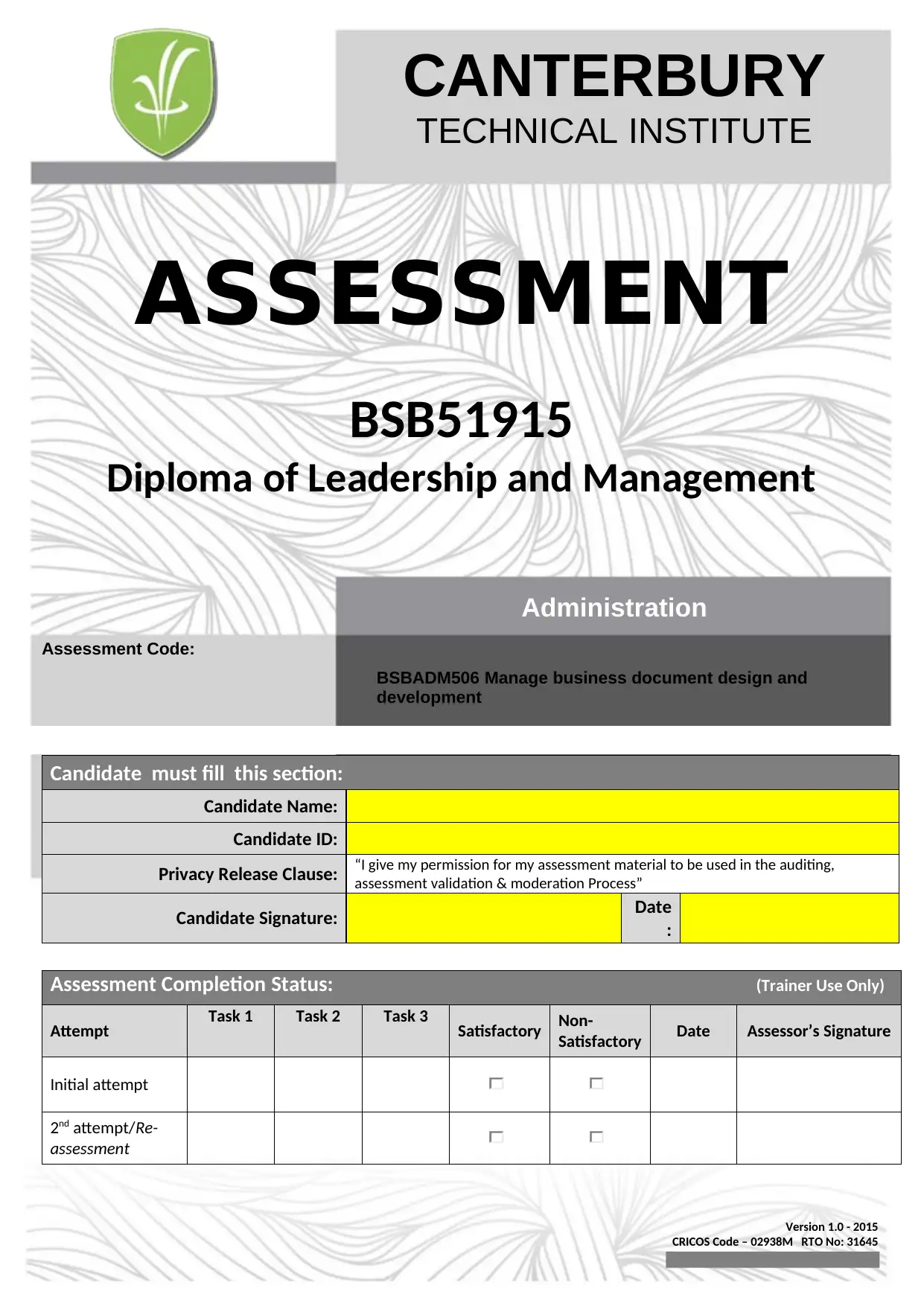
Candidate must fill this section:
Candidate Name:
Candidate ID:
Privacy Release Clause: “I give my permission for my assessment material to be used in the auditing,
assessment validation & moderation Process”
Candidate Signature: Date
:
Assessment Completion Status: (Trainer Use Only)
Attempt Task 1 Task 2 Task 3 Satisfactory Non-
Satisfactory Date Assessor’s Signature
Initial attempt
2nd attempt/Re-
assessment
CANTERBURY
TECHNICAL INSTITUTE
BSBADM506 Manage business document design and
development
Administration
Version 1.0 - 2015
CRICOS Code – 02938M RTO No: 31645
ASSESSMENT
BSB51915
Diploma of Leadership and Management
Assessment Code:
Candidate Name:
Candidate ID:
Privacy Release Clause: “I give my permission for my assessment material to be used in the auditing,
assessment validation & moderation Process”
Candidate Signature: Date
:
Assessment Completion Status: (Trainer Use Only)
Attempt Task 1 Task 2 Task 3 Satisfactory Non-
Satisfactory Date Assessor’s Signature
Initial attempt
2nd attempt/Re-
assessment
CANTERBURY
TECHNICAL INSTITUTE
BSBADM506 Manage business document design and
development
Administration
Version 1.0 - 2015
CRICOS Code – 02938M RTO No: 31645
ASSESSMENT
BSB51915
Diploma of Leadership and Management
Assessment Code:
Paraphrase This Document
Need a fresh take? Get an instant paraphrase of this document with our AI Paraphraser
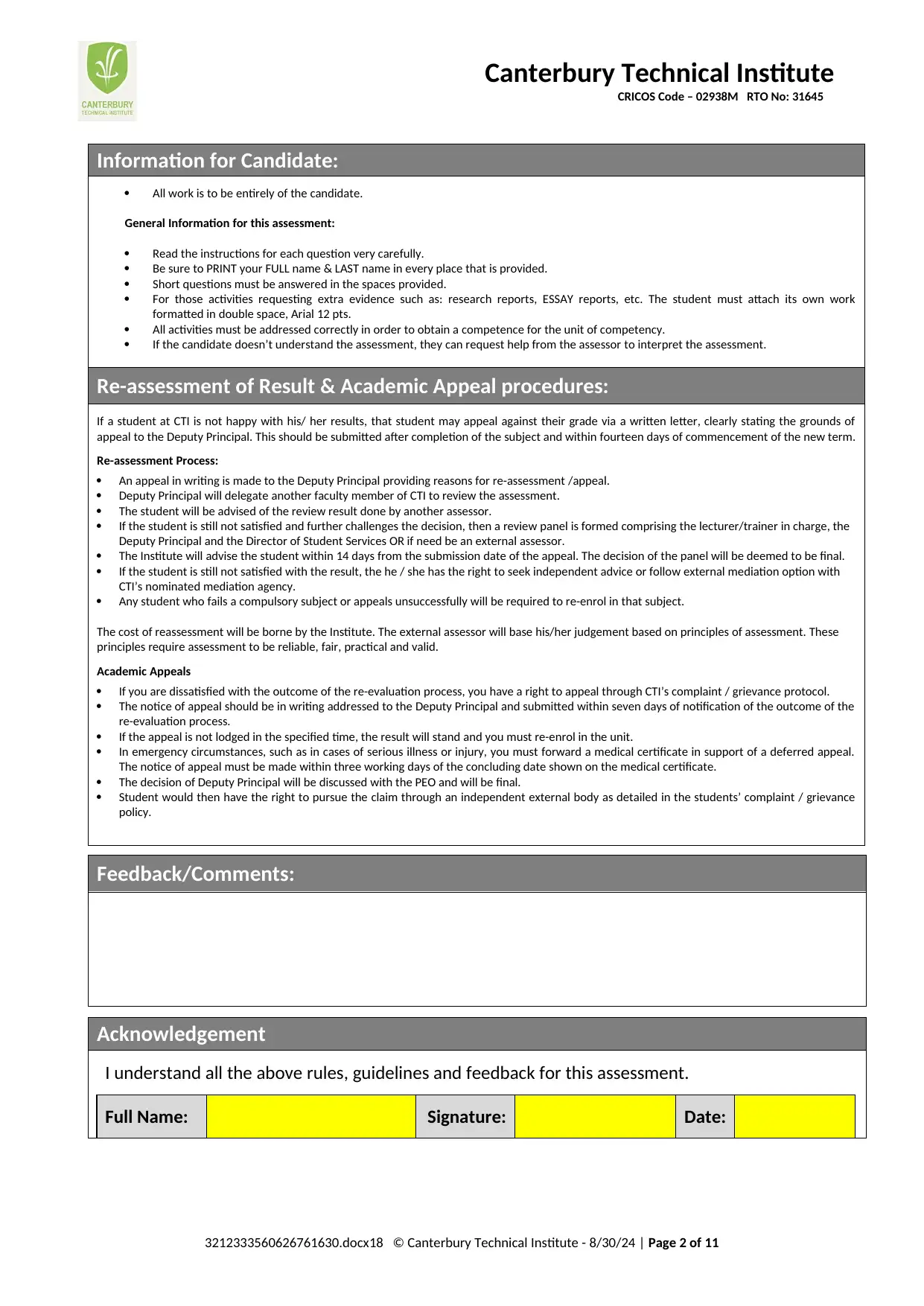
Canterbury Technical Institute
CRICOS Code – 02938M RTO No: 31645
Information for Candidate:
All work is to be entirely of the candidate.
General Information for this assessment:
Read the instructions for each question very carefully.
Be sure to PRINT your FULL name & LAST name in every place that is provided.
Short questions must be answered in the spaces provided.
For those activities requesting extra evidence such as: research reports, ESSAY reports, etc. The student must attach its own work
formatted in double space, Arial 12 pts.
All activities must be addressed correctly in order to obtain a competence for the unit of competency.
If the candidate doesn’t understand the assessment, they can request help from the assessor to interpret the assessment.
Re-assessment of Result & Academic Appeal procedures:
If a student at CTI is not happy with his/ her results, that student may appeal against their grade via a written letter, clearly stating the grounds of
appeal to the Deputy Principal. This should be submitted after completion of the subject and within fourteen days of commencement of the new term.
Re-assessment Process:
An appeal in writing is made to the Deputy Principal providing reasons for re-assessment /appeal.
Deputy Principal will delegate another faculty member of CTI to review the assessment.
The student will be advised of the review result done by another assessor.
If the student is still not satisfied and further challenges the decision, then a review panel is formed comprising the lecturer/trainer in charge, the
Deputy Principal and the Director of Student Services OR if need be an external assessor.
The Institute will advise the student within 14 days from the submission date of the appeal. The decision of the panel will be deemed to be final.
If the student is still not satisfied with the result, the he / she has the right to seek independent advice or follow external mediation option with
CTI’s nominated mediation agency.
Any student who fails a compulsory subject or appeals unsuccessfully will be required to re-enrol in that subject.
The cost of reassessment will be borne by the Institute. The external assessor will base his/her judgement based on principles of assessment. These
principles require assessment to be reliable, fair, practical and valid.
Academic Appeals
If you are dissatisfied with the outcome of the re-evaluation process, you have a right to appeal through CTI’s complaint / grievance protocol.
The notice of appeal should be in writing addressed to the Deputy Principal and submitted within seven days of notification of the outcome of the
re-evaluation process.
If the appeal is not lodged in the specified time, the result will stand and you must re-enrol in the unit.
In emergency circumstances, such as in cases of serious illness or injury, you must forward a medical certificate in support of a deferred appeal.
The notice of appeal must be made within three working days of the concluding date shown on the medical certificate.
The decision of Deputy Principal will be discussed with the PEO and will be final.
Student would then have the right to pursue the claim through an independent external body as detailed in the students’ complaint / grievance
policy.
Feedback/Comments:
Acknowledgement
I understand all the above rules, guidelines and feedback for this assessment.
Full Name: Signature: Date:
3212333560626761630.docx18 © Canterbury Technical Institute - 8/30/24 | Page 2 of 11
CRICOS Code – 02938M RTO No: 31645
Information for Candidate:
All work is to be entirely of the candidate.
General Information for this assessment:
Read the instructions for each question very carefully.
Be sure to PRINT your FULL name & LAST name in every place that is provided.
Short questions must be answered in the spaces provided.
For those activities requesting extra evidence such as: research reports, ESSAY reports, etc. The student must attach its own work
formatted in double space, Arial 12 pts.
All activities must be addressed correctly in order to obtain a competence for the unit of competency.
If the candidate doesn’t understand the assessment, they can request help from the assessor to interpret the assessment.
Re-assessment of Result & Academic Appeal procedures:
If a student at CTI is not happy with his/ her results, that student may appeal against their grade via a written letter, clearly stating the grounds of
appeal to the Deputy Principal. This should be submitted after completion of the subject and within fourteen days of commencement of the new term.
Re-assessment Process:
An appeal in writing is made to the Deputy Principal providing reasons for re-assessment /appeal.
Deputy Principal will delegate another faculty member of CTI to review the assessment.
The student will be advised of the review result done by another assessor.
If the student is still not satisfied and further challenges the decision, then a review panel is formed comprising the lecturer/trainer in charge, the
Deputy Principal and the Director of Student Services OR if need be an external assessor.
The Institute will advise the student within 14 days from the submission date of the appeal. The decision of the panel will be deemed to be final.
If the student is still not satisfied with the result, the he / she has the right to seek independent advice or follow external mediation option with
CTI’s nominated mediation agency.
Any student who fails a compulsory subject or appeals unsuccessfully will be required to re-enrol in that subject.
The cost of reassessment will be borne by the Institute. The external assessor will base his/her judgement based on principles of assessment. These
principles require assessment to be reliable, fair, practical and valid.
Academic Appeals
If you are dissatisfied with the outcome of the re-evaluation process, you have a right to appeal through CTI’s complaint / grievance protocol.
The notice of appeal should be in writing addressed to the Deputy Principal and submitted within seven days of notification of the outcome of the
re-evaluation process.
If the appeal is not lodged in the specified time, the result will stand and you must re-enrol in the unit.
In emergency circumstances, such as in cases of serious illness or injury, you must forward a medical certificate in support of a deferred appeal.
The notice of appeal must be made within three working days of the concluding date shown on the medical certificate.
The decision of Deputy Principal will be discussed with the PEO and will be final.
Student would then have the right to pursue the claim through an independent external body as detailed in the students’ complaint / grievance
policy.
Feedback/Comments:
Acknowledgement
I understand all the above rules, guidelines and feedback for this assessment.
Full Name: Signature: Date:
3212333560626761630.docx18 © Canterbury Technical Institute - 8/30/24 | Page 2 of 11
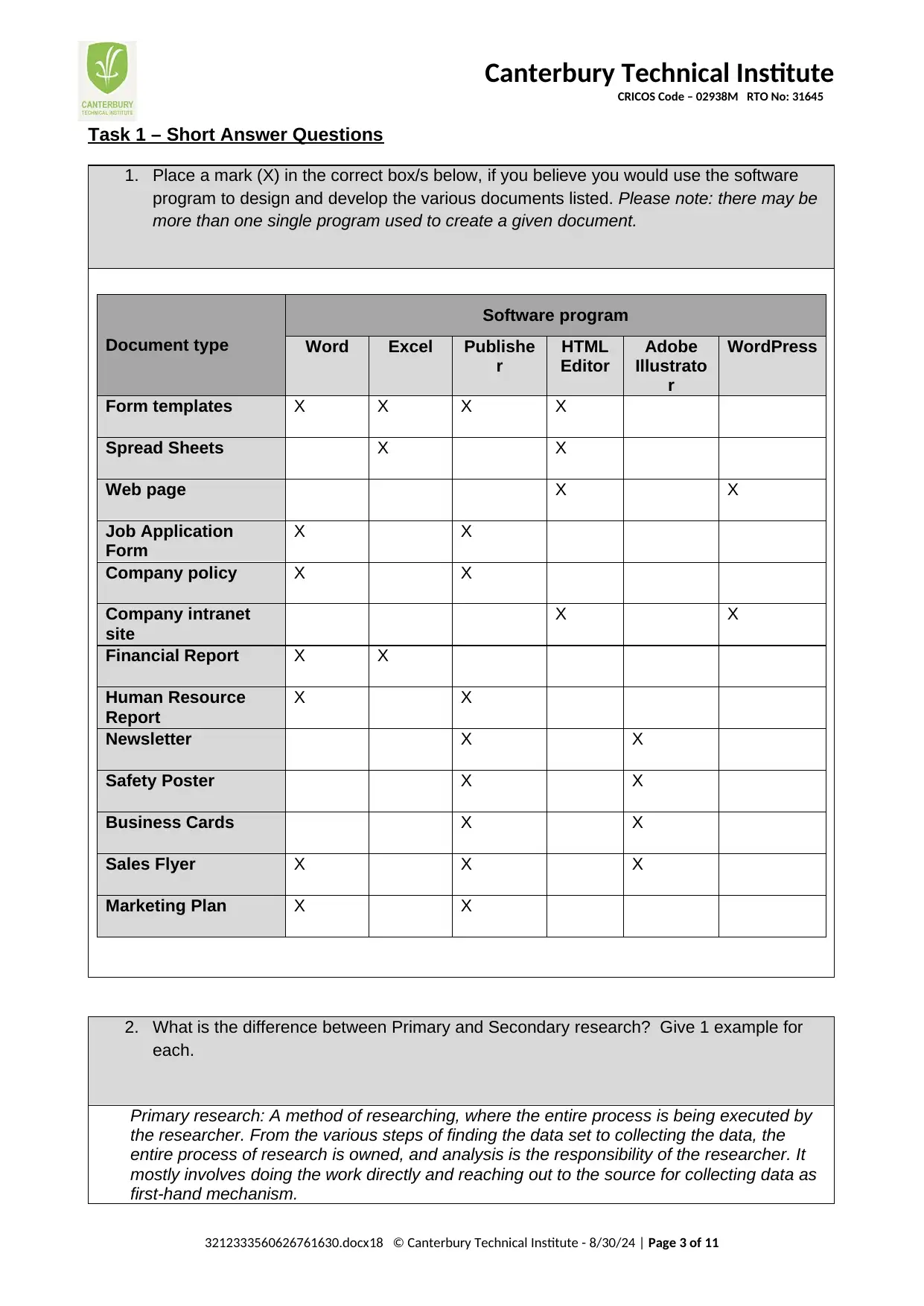
Canterbury Technical Institute
CRICOS Code – 02938M RTO No: 31645
Task 1 – Short Answer Questions
1. Place a mark (X) in the correct box/s below, if you believe you would use the software
program to design and develop the various documents listed. Please note: there may be
more than one single program used to create a given document.
2. What is the difference between Primary and Secondary research? Give 1 example for
each.
Primary research: A method of researching, where the entire process is being executed by
the researcher. From the various steps of finding the data set to collecting the data, the
entire process of research is owned, and analysis is the responsibility of the researcher. It
mostly involves doing the work directly and reaching out to the source for collecting data as
first-hand mechanism.
3212333560626761630.docx18 © Canterbury Technical Institute - 8/30/24 | Page 3 of 11
Document type
Software program
Word Excel Publishe
r
HTML
Editor
Adobe
Illustrato
r
WordPress
Form templates X X X X
Spread Sheets X X
Web page X X
Job Application
Form
X X
Company policy X X
Company intranet
site
X X
Financial Report X X
Human Resource
Report
X X
Newsletter X X
Safety Poster X X
Business Cards X X
Sales Flyer X X X
Marketing Plan X X
CRICOS Code – 02938M RTO No: 31645
Task 1 – Short Answer Questions
1. Place a mark (X) in the correct box/s below, if you believe you would use the software
program to design and develop the various documents listed. Please note: there may be
more than one single program used to create a given document.
2. What is the difference between Primary and Secondary research? Give 1 example for
each.
Primary research: A method of researching, where the entire process is being executed by
the researcher. From the various steps of finding the data set to collecting the data, the
entire process of research is owned, and analysis is the responsibility of the researcher. It
mostly involves doing the work directly and reaching out to the source for collecting data as
first-hand mechanism.
3212333560626761630.docx18 © Canterbury Technical Institute - 8/30/24 | Page 3 of 11
Document type
Software program
Word Excel Publishe
r
HTML
Editor
Adobe
Illustrato
r
WordPress
Form templates X X X X
Spread Sheets X X
Web page X X
Job Application
Form
X X
Company policy X X
Company intranet
site
X X
Financial Report X X
Human Resource
Report
X X
Newsletter X X
Safety Poster X X
Business Cards X X
Sales Flyer X X X
Marketing Plan X X
⊘ This is a preview!⊘
Do you want full access?
Subscribe today to unlock all pages.

Trusted by 1+ million students worldwide

Canterbury Technical Institute
CRICOS Code – 02938M RTO No: 31645
A primary research can be done through various ways, like observations, surveys,
interviews, focus group discussions, questionnaire and many more. The primary
researching process is done to perform analysis of fresh and unused data.
Example: An example of primary data research are the population census calculation for a
country with demographic detailing is a primary data collection and research mechanism.
Secondary research: A secondary research is secondary because it involves analysis on
the data that is not originally collected by the researcher. Based on the data available,
collected by someone else as source information, the researcher tends to process and align
findings on information available rather than making the first-had attempt to collect the
same.
A secondary research is performed on data from governmental website data, trade reports,
various industry publishes data reports and other legitimate data supplying entities. The
primary purpose for secondary data analysis is to check or verify the primary research
observations or to save time.
Example: The analysis of trends in the global market to predict the upcoming rise or fall in
the shares and stock sector, is done on previous years performance, market information
and current data trends.
3. What is the difference between Qualitative and Quantitative data? Give one example for
each.
Qualitative data: The qualitative data is the data of the form of raw content that is relative to
attributes and properties. This type of data is difficult to measure on numerical and
statistical grounds. It is majorly used as a component of exploratory researches, where the
subjective approach is more prominent. The data form is more unstructured and non-
hierarchical with concentration towards the depth of any concept.
Example: The name of each student in the classroom collected for attendance purposes
accounts to be the qualitative data.
Quantitative data: The quantitative data is a different form where the amount of material is
quantifiable and c an be expressed in numerical terms. A very structured and hierarchical
arrangement is possible with this data set, aiming at objective values of the information
collected. Used to derive the proven conclusion, with reliable outcomes, quantitative data
offers more confidence and level of precision.
Example: How many children with the same name are a part of a class, is a measurable
quantitative data.
4. What is a macro, how is it used (give an example), and how can it be tested?
A group of actions or tasks that are grouped together, in the form as to perform a specific action
repetitively, with greater efficiency and ease is clubbed together as Macros. Simply put, a series
of small commands recorded together to perform a set of recurring actions, as an automated
process is called as a Macro.
A Macro is used for certain actions that are repetitive or required very often during the work on a
Word document. Therefore, a series of instructions are recorded and saved in the form of a
macro, assigning a button or a keyboard command to it. Each time the macro is called, it
performs the assigned function and executes the instructions given.
3212333560626761630.docx18 © Canterbury Technical Institute - 8/30/24 | Page 4 of 11
CRICOS Code – 02938M RTO No: 31645
A primary research can be done through various ways, like observations, surveys,
interviews, focus group discussions, questionnaire and many more. The primary
researching process is done to perform analysis of fresh and unused data.
Example: An example of primary data research are the population census calculation for a
country with demographic detailing is a primary data collection and research mechanism.
Secondary research: A secondary research is secondary because it involves analysis on
the data that is not originally collected by the researcher. Based on the data available,
collected by someone else as source information, the researcher tends to process and align
findings on information available rather than making the first-had attempt to collect the
same.
A secondary research is performed on data from governmental website data, trade reports,
various industry publishes data reports and other legitimate data supplying entities. The
primary purpose for secondary data analysis is to check or verify the primary research
observations or to save time.
Example: The analysis of trends in the global market to predict the upcoming rise or fall in
the shares and stock sector, is done on previous years performance, market information
and current data trends.
3. What is the difference between Qualitative and Quantitative data? Give one example for
each.
Qualitative data: The qualitative data is the data of the form of raw content that is relative to
attributes and properties. This type of data is difficult to measure on numerical and
statistical grounds. It is majorly used as a component of exploratory researches, where the
subjective approach is more prominent. The data form is more unstructured and non-
hierarchical with concentration towards the depth of any concept.
Example: The name of each student in the classroom collected for attendance purposes
accounts to be the qualitative data.
Quantitative data: The quantitative data is a different form where the amount of material is
quantifiable and c an be expressed in numerical terms. A very structured and hierarchical
arrangement is possible with this data set, aiming at objective values of the information
collected. Used to derive the proven conclusion, with reliable outcomes, quantitative data
offers more confidence and level of precision.
Example: How many children with the same name are a part of a class, is a measurable
quantitative data.
4. What is a macro, how is it used (give an example), and how can it be tested?
A group of actions or tasks that are grouped together, in the form as to perform a specific action
repetitively, with greater efficiency and ease is clubbed together as Macros. Simply put, a series
of small commands recorded together to perform a set of recurring actions, as an automated
process is called as a Macro.
A Macro is used for certain actions that are repetitive or required very often during the work on a
Word document. Therefore, a series of instructions are recorded and saved in the form of a
macro, assigning a button or a keyboard command to it. Each time the macro is called, it
performs the assigned function and executes the instructions given.
3212333560626761630.docx18 © Canterbury Technical Institute - 8/30/24 | Page 4 of 11
Paraphrase This Document
Need a fresh take? Get an instant paraphrase of this document with our AI Paraphraser

Canterbury Technical Institute
CRICOS Code – 02938M RTO No: 31645
For example, a set of instructions can be recorded to capture the current date on any form or
document template. Each time this macro is recalled, on whatever date, it returns that day’s date
in any specifically chosen format.
To test a Macro, the macro is viewed and the ‘run’ instruction is executed. One can specify if a
step by step macro action is to be tested or overall functionality is to be tested. If the outcome at
the macro number box returns a zero value, the macro is tested successfully. Any other number
indicates an error.
5. What are file naming conventions, and why are they useful?
File naming conventions are a set of guidelines that are followed as document code for naming
the files. They describe a number of naming rules that define a link between the content of the
file, its motive and its link to other related files or documents. The naming convention not only
acts as a standard, but also helps in delivering documents that are non-ambiguous, relative and
displays meaningful information about the content of the file without opening it.
A set naming convention, within a project or an organization is also a mark of organized and
systematic work procedures. A well-defined, ease to understand yet very convenient naming
convention, accepted in an organization at all levels signifies the understanding and close
association of all functional units at a workplace.
6. Regarding the handling of personal information and data storage, what legislative
requirements/Acts would apply in Australia?
For managing and handling the personal information and data storage, the Australian
government releases ‘Guide to securing personal information’ that acts as guidelines under the
Privacy Act 1988. This guide helps with the do’s and don’ts with respect to the withheld user
data. The guidelines prevent the misuse, interference, loss, unauthorised access, modification or
disclosure. Not only does it manage the holding or acquiring of personal information, the act also
guides with destroying or de-identifying personal information once it is no longer needed or
required. The Office of Australian Information Commissioner (OAIC) oversees the
implementation of the act with all entities.
The OAIC releases Privacy regulatory action policy and Australian Privacy Principles guidelines
(APP) for detailed clarifications on when to use, how to use, where to be used etc. All FAQs
relative to the privacy policy can be observed in these documents for answers.
7. What is a style guide and how is it used?
A style guide is a guidance manual in the form of standards for writing, formatting and design of
documents. It makes the documents presentable, homogenous and consistent. Also referred to
as, Style Sheets, sometimes, covers all the formatting related prospects in a file. It can be used
to standardize documents for any group or organization, making effective and look alike
templates.
A style sheet or style guide can be made with specific instructions for punctuations, word
formatting, language formatting, text formatting, margins, page numbers, spacing, font sizes and
many more. Out of the 950 instructions available over the Word’s Menu bar, more than half of
them can be configured, saved and named under a specific style guide. They can also be used
in other documents, by importing the same style sheet from the library, where it is saved.
3212333560626761630.docx18 © Canterbury Technical Institute - 8/30/24 | Page 5 of 11
CRICOS Code – 02938M RTO No: 31645
For example, a set of instructions can be recorded to capture the current date on any form or
document template. Each time this macro is recalled, on whatever date, it returns that day’s date
in any specifically chosen format.
To test a Macro, the macro is viewed and the ‘run’ instruction is executed. One can specify if a
step by step macro action is to be tested or overall functionality is to be tested. If the outcome at
the macro number box returns a zero value, the macro is tested successfully. Any other number
indicates an error.
5. What are file naming conventions, and why are they useful?
File naming conventions are a set of guidelines that are followed as document code for naming
the files. They describe a number of naming rules that define a link between the content of the
file, its motive and its link to other related files or documents. The naming convention not only
acts as a standard, but also helps in delivering documents that are non-ambiguous, relative and
displays meaningful information about the content of the file without opening it.
A set naming convention, within a project or an organization is also a mark of organized and
systematic work procedures. A well-defined, ease to understand yet very convenient naming
convention, accepted in an organization at all levels signifies the understanding and close
association of all functional units at a workplace.
6. Regarding the handling of personal information and data storage, what legislative
requirements/Acts would apply in Australia?
For managing and handling the personal information and data storage, the Australian
government releases ‘Guide to securing personal information’ that acts as guidelines under the
Privacy Act 1988. This guide helps with the do’s and don’ts with respect to the withheld user
data. The guidelines prevent the misuse, interference, loss, unauthorised access, modification or
disclosure. Not only does it manage the holding or acquiring of personal information, the act also
guides with destroying or de-identifying personal information once it is no longer needed or
required. The Office of Australian Information Commissioner (OAIC) oversees the
implementation of the act with all entities.
The OAIC releases Privacy regulatory action policy and Australian Privacy Principles guidelines
(APP) for detailed clarifications on when to use, how to use, where to be used etc. All FAQs
relative to the privacy policy can be observed in these documents for answers.
7. What is a style guide and how is it used?
A style guide is a guidance manual in the form of standards for writing, formatting and design of
documents. It makes the documents presentable, homogenous and consistent. Also referred to
as, Style Sheets, sometimes, covers all the formatting related prospects in a file. It can be used
to standardize documents for any group or organization, making effective and look alike
templates.
A style sheet or style guide can be made with specific instructions for punctuations, word
formatting, language formatting, text formatting, margins, page numbers, spacing, font sizes and
many more. Out of the 950 instructions available over the Word’s Menu bar, more than half of
them can be configured, saved and named under a specific style guide. They can also be used
in other documents, by importing the same style sheet from the library, where it is saved.
3212333560626761630.docx18 © Canterbury Technical Institute - 8/30/24 | Page 5 of 11
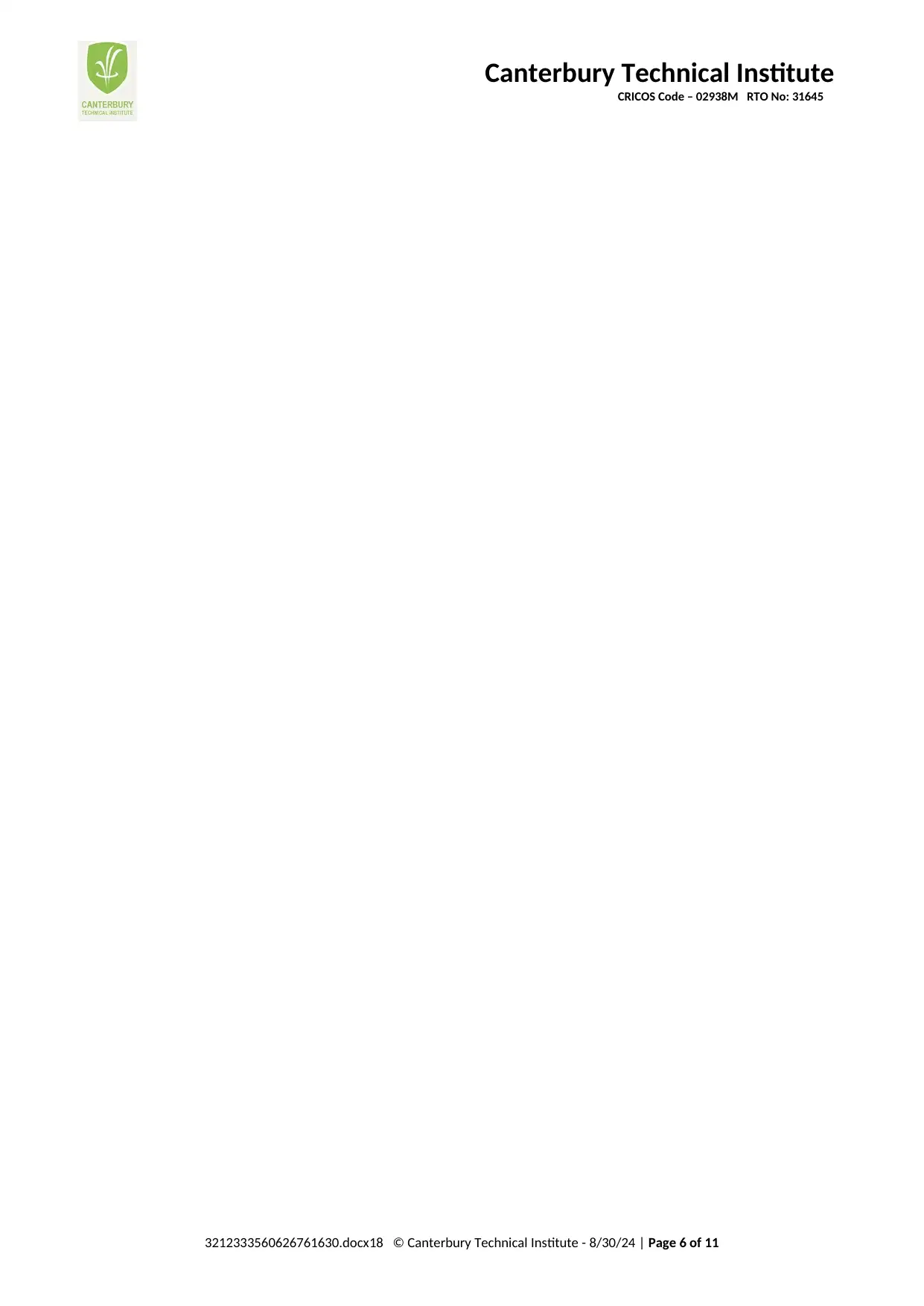
Canterbury Technical Institute
CRICOS Code – 02938M RTO No: 31645
3212333560626761630.docx18 © Canterbury Technical Institute - 8/30/24 | Page 6 of 11
CRICOS Code – 02938M RTO No: 31645
3212333560626761630.docx18 © Canterbury Technical Institute - 8/30/24 | Page 6 of 11
⊘ This is a preview!⊘
Do you want full access?
Subscribe today to unlock all pages.

Trusted by 1+ million students worldwide
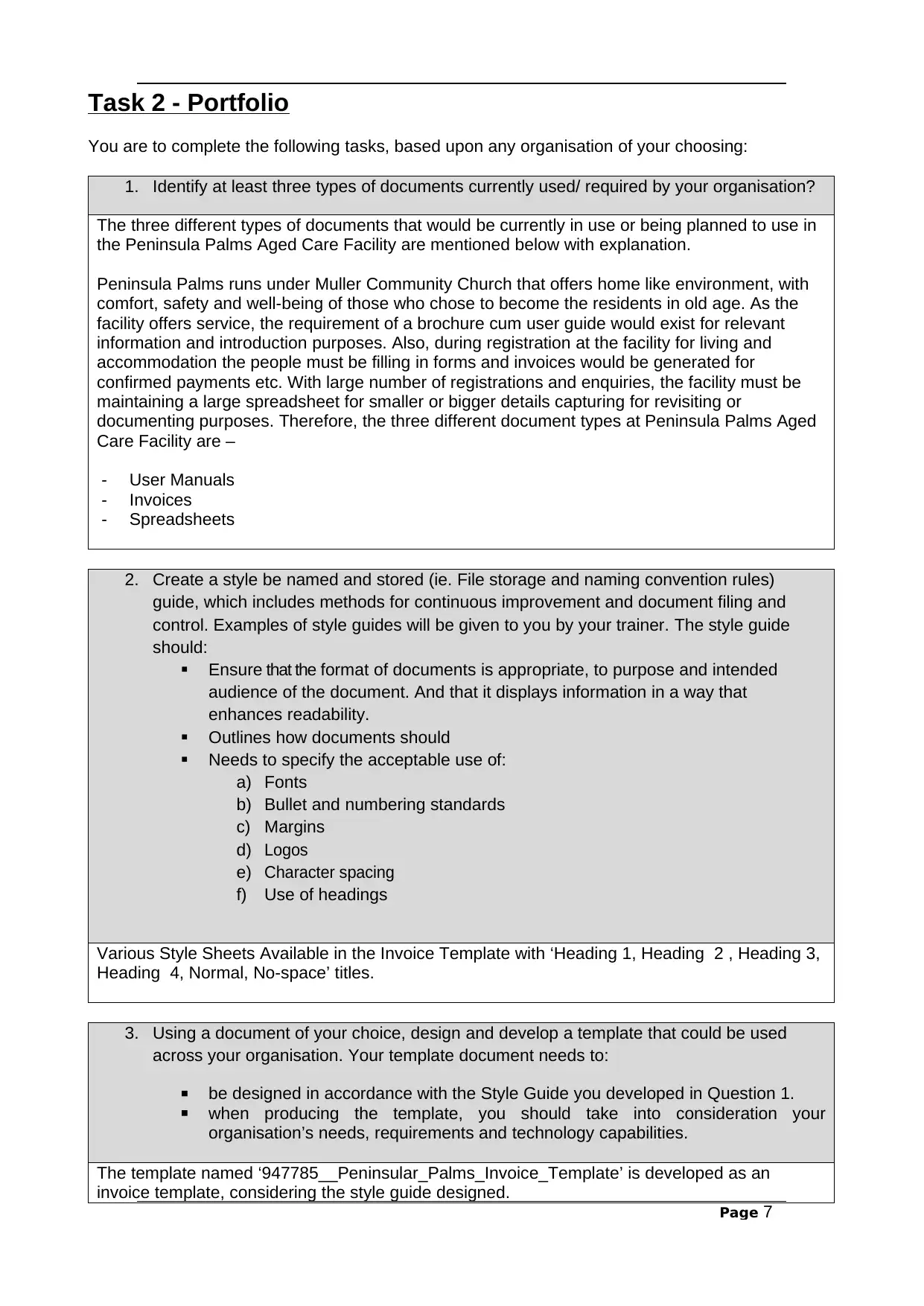
Page 7
Task 2 - Portfolio
You are to complete the following tasks, based upon any organisation of your choosing:
1. Identify at least three types of documents currently used/ required by your organisation?
The three different types of documents that would be currently in use or being planned to use in
the Peninsula Palms Aged Care Facility are mentioned below with explanation.
Peninsula Palms runs under Muller Community Church that offers home like environment, with
comfort, safety and well-being of those who chose to become the residents in old age. As the
facility offers service, the requirement of a brochure cum user guide would exist for relevant
information and introduction purposes. Also, during registration at the facility for living and
accommodation the people must be filling in forms and invoices would be generated for
confirmed payments etc. With large number of registrations and enquiries, the facility must be
maintaining a large spreadsheet for smaller or bigger details capturing for revisiting or
documenting purposes. Therefore, the three different document types at Peninsula Palms Aged
Care Facility are –
- User Manuals
- Invoices
- Spreadsheets
2. Create a style be named and stored (ie. File storage and naming convention rules)
guide, which includes methods for continuous improvement and document filing and
control. Examples of style guides will be given to you by your trainer. The style guide
should:
Ensure that the format of documents is appropriate, to purpose and intended
audience of the document. And that it displays information in a way that
enhances readability.
Outlines how documents should
Needs to specify the acceptable use of:
a) Fonts
b) Bullet and numbering standards
c) Margins
d) Logos
e) Character spacing
f) Use of headings
Various Style Sheets Available in the Invoice Template with ‘Heading 1, Heading 2 , Heading 3,
Heading 4, Normal, No-space’ titles.
3. Using a document of your choice, design and develop a template that could be used
across your organisation. Your template document needs to:
be designed in accordance with the Style Guide you developed in Question 1.
when producing the template, you should take into consideration your
organisation’s needs, requirements and technology capabilities.
The template named ‘947785__Peninsular_Palms_Invoice_Template’ is developed as an
invoice template, considering the style guide designed.
Task 2 - Portfolio
You are to complete the following tasks, based upon any organisation of your choosing:
1. Identify at least three types of documents currently used/ required by your organisation?
The three different types of documents that would be currently in use or being planned to use in
the Peninsula Palms Aged Care Facility are mentioned below with explanation.
Peninsula Palms runs under Muller Community Church that offers home like environment, with
comfort, safety and well-being of those who chose to become the residents in old age. As the
facility offers service, the requirement of a brochure cum user guide would exist for relevant
information and introduction purposes. Also, during registration at the facility for living and
accommodation the people must be filling in forms and invoices would be generated for
confirmed payments etc. With large number of registrations and enquiries, the facility must be
maintaining a large spreadsheet for smaller or bigger details capturing for revisiting or
documenting purposes. Therefore, the three different document types at Peninsula Palms Aged
Care Facility are –
- User Manuals
- Invoices
- Spreadsheets
2. Create a style be named and stored (ie. File storage and naming convention rules)
guide, which includes methods for continuous improvement and document filing and
control. Examples of style guides will be given to you by your trainer. The style guide
should:
Ensure that the format of documents is appropriate, to purpose and intended
audience of the document. And that it displays information in a way that
enhances readability.
Outlines how documents should
Needs to specify the acceptable use of:
a) Fonts
b) Bullet and numbering standards
c) Margins
d) Logos
e) Character spacing
f) Use of headings
Various Style Sheets Available in the Invoice Template with ‘Heading 1, Heading 2 , Heading 3,
Heading 4, Normal, No-space’ titles.
3. Using a document of your choice, design and develop a template that could be used
across your organisation. Your template document needs to:
be designed in accordance with the Style Guide you developed in Question 1.
when producing the template, you should take into consideration your
organisation’s needs, requirements and technology capabilities.
The template named ‘947785__Peninsular_Palms_Invoice_Template’ is developed as an
invoice template, considering the style guide designed.
Paraphrase This Document
Need a fresh take? Get an instant paraphrase of this document with our AI Paraphraser
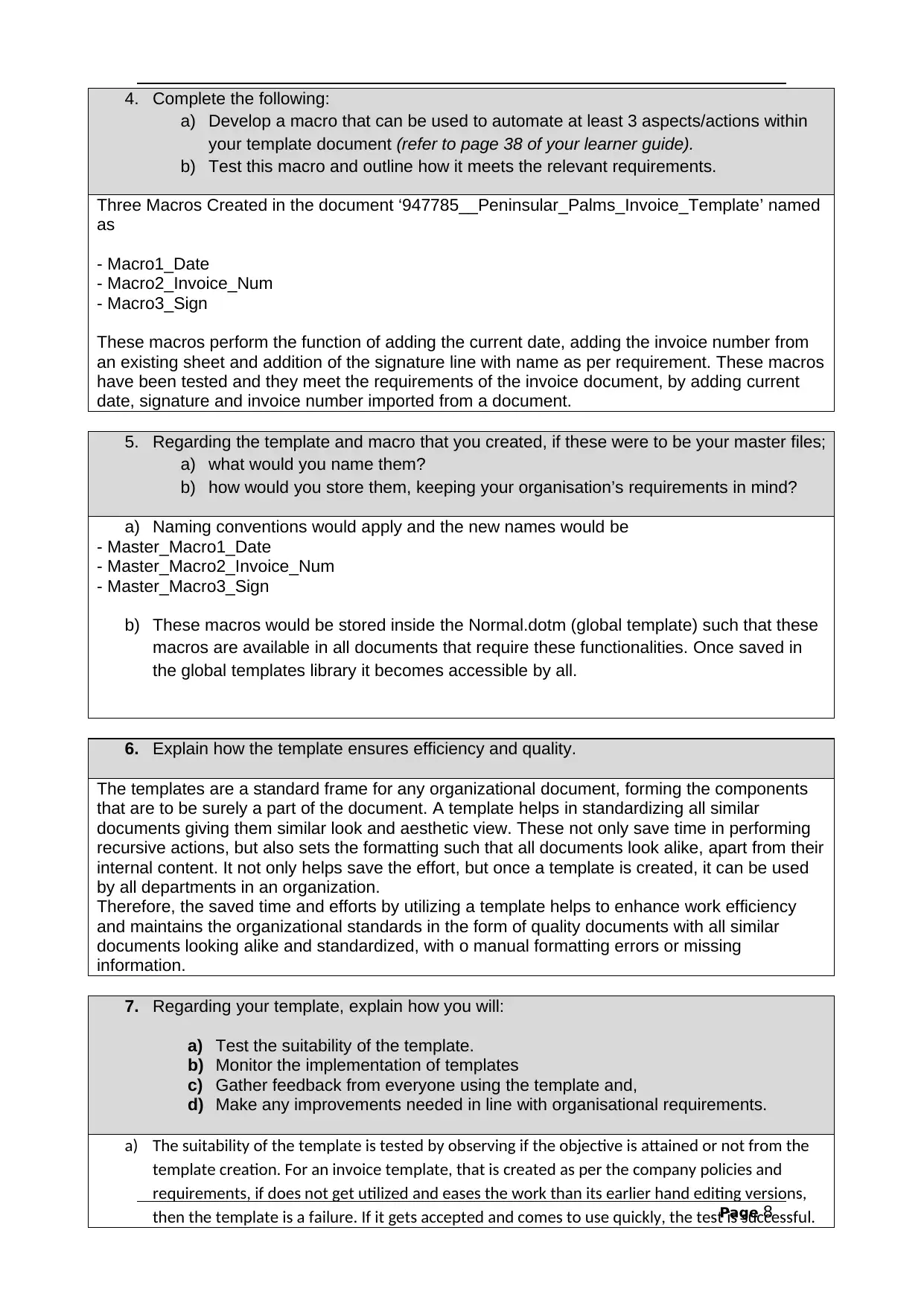
Page 8
4. Complete the following:
a) Develop a macro that can be used to automate at least 3 aspects/actions within
your template document (refer to page 38 of your learner guide).
b) Test this macro and outline how it meets the relevant requirements.
Three Macros Created in the document ‘947785__Peninsular_Palms_Invoice_Template’ named
as
- Macro1_Date
- Macro2_Invoice_Num
- Macro3_Sign
These macros perform the function of adding the current date, adding the invoice number from
an existing sheet and addition of the signature line with name as per requirement. These macros
have been tested and they meet the requirements of the invoice document, by adding current
date, signature and invoice number imported from a document.
5. Regarding the template and macro that you created, if these were to be your master files;
a) what would you name them?
b) how would you store them, keeping your organisation’s requirements in mind?
a) Naming conventions would apply and the new names would be
- Master_Macro1_Date
- Master_Macro2_Invoice_Num
- Master_Macro3_Sign
b) These macros would be stored inside the Normal.dotm (global template) such that these
macros are available in all documents that require these functionalities. Once saved in
the global templates library it becomes accessible by all.
6. Explain how the template ensures efficiency and quality.
The templates are a standard frame for any organizational document, forming the components
that are to be surely a part of the document. A template helps in standardizing all similar
documents giving them similar look and aesthetic view. These not only save time in performing
recursive actions, but also sets the formatting such that all documents look alike, apart from their
internal content. It not only helps save the effort, but once a template is created, it can be used
by all departments in an organization.
Therefore, the saved time and efforts by utilizing a template helps to enhance work efficiency
and maintains the organizational standards in the form of quality documents with all similar
documents looking alike and standardized, with o manual formatting errors or missing
information.
7. Regarding your template, explain how you will:
a) Test the suitability of the template.
b) Monitor the implementation of templates
c) Gather feedback from everyone using the template and,
d) Make any improvements needed in line with organisational requirements.
a) The suitability of the template is tested by observing if the objective is attained or not from the
template creation. For an invoice template, that is created as per the company policies and
requirements, if does not get utilized and eases the work than its earlier hand editing versions,
then the template is a failure. If it gets accepted and comes to use quickly, the test is successful.
4. Complete the following:
a) Develop a macro that can be used to automate at least 3 aspects/actions within
your template document (refer to page 38 of your learner guide).
b) Test this macro and outline how it meets the relevant requirements.
Three Macros Created in the document ‘947785__Peninsular_Palms_Invoice_Template’ named
as
- Macro1_Date
- Macro2_Invoice_Num
- Macro3_Sign
These macros perform the function of adding the current date, adding the invoice number from
an existing sheet and addition of the signature line with name as per requirement. These macros
have been tested and they meet the requirements of the invoice document, by adding current
date, signature and invoice number imported from a document.
5. Regarding the template and macro that you created, if these were to be your master files;
a) what would you name them?
b) how would you store them, keeping your organisation’s requirements in mind?
a) Naming conventions would apply and the new names would be
- Master_Macro1_Date
- Master_Macro2_Invoice_Num
- Master_Macro3_Sign
b) These macros would be stored inside the Normal.dotm (global template) such that these
macros are available in all documents that require these functionalities. Once saved in
the global templates library it becomes accessible by all.
6. Explain how the template ensures efficiency and quality.
The templates are a standard frame for any organizational document, forming the components
that are to be surely a part of the document. A template helps in standardizing all similar
documents giving them similar look and aesthetic view. These not only save time in performing
recursive actions, but also sets the formatting such that all documents look alike, apart from their
internal content. It not only helps save the effort, but once a template is created, it can be used
by all departments in an organization.
Therefore, the saved time and efforts by utilizing a template helps to enhance work efficiency
and maintains the organizational standards in the form of quality documents with all similar
documents looking alike and standardized, with o manual formatting errors or missing
information.
7. Regarding your template, explain how you will:
a) Test the suitability of the template.
b) Monitor the implementation of templates
c) Gather feedback from everyone using the template and,
d) Make any improvements needed in line with organisational requirements.
a) The suitability of the template is tested by observing if the objective is attained or not from the
template creation. For an invoice template, that is created as per the company policies and
requirements, if does not get utilized and eases the work than its earlier hand editing versions,
then the template is a failure. If it gets accepted and comes to use quickly, the test is successful.

Page 9
b) To monitor the implementation of templates, the released documents, like invoices can be
randomly checked for the use of templates. Also, using the technological functionality, the
template can be placed in a shared folder and the count of accessibility of the template from the
shared folder can be viewed and checked. It can also be monitored as to which systems have
accessed the template and which have not.
c) To have fair and justified inputs as feedbacks, the people using the templates and its earlier
versions can be approached for. The identity can be kept hidden, in case if openness to sharing
feedback lags. Even the management and clients using the templates can be interacted with to
check on their experience for the template.
d) To ensure that any improvement suggestions that are helpful in making the template a better
version, the master file, that is saved on global library can be altered and changed for reflecting
new changes. The team can be notified for the improvement and can be requested for retrying
and sharing feedback over with new modifications.
8. What are the standards regarding the creation and maintenance of business
documentation within your organisation, complete the table below? If your organisation
doesn’t have documentation standards, create them; ensuring that such standards are
realistic and measurable?
Documentation standards Means of achievement
Documents suited to user requirements - Checking for most required template
or format
- Checking for documents giving most
standing or wait time for processing
- Developing the documents and
testing with usuability acceptance
tests
Inclusion of relevant and understandable
information
- Discussing the requirements in a
standard document from relevant
people
- Identifying the management requisite
out of the document
- Looking for global parameters and
requirements being followed in
market
Decreased cost and improved efficiency - Finding out the best and sustainable
alternative for printing
- Checking the legitimacy of
requirements in docuementation
- Identifying if digitization is possible,
without printouts as e-copies and
PDFs
Technical accuracy - Making sure that there are no errors
- Ensuring all automation plug-ins and
macros are tested and running
Standards of grammar and style - Automatic spell and grammatical
check
- Final proof reading before print-out
Means of saving and storing - Using shared or common databse or
cloud storage as document
repository
9. How does your organisation identify the need for documentation changes and implement
b) To monitor the implementation of templates, the released documents, like invoices can be
randomly checked for the use of templates. Also, using the technological functionality, the
template can be placed in a shared folder and the count of accessibility of the template from the
shared folder can be viewed and checked. It can also be monitored as to which systems have
accessed the template and which have not.
c) To have fair and justified inputs as feedbacks, the people using the templates and its earlier
versions can be approached for. The identity can be kept hidden, in case if openness to sharing
feedback lags. Even the management and clients using the templates can be interacted with to
check on their experience for the template.
d) To ensure that any improvement suggestions that are helpful in making the template a better
version, the master file, that is saved on global library can be altered and changed for reflecting
new changes. The team can be notified for the improvement and can be requested for retrying
and sharing feedback over with new modifications.
8. What are the standards regarding the creation and maintenance of business
documentation within your organisation, complete the table below? If your organisation
doesn’t have documentation standards, create them; ensuring that such standards are
realistic and measurable?
Documentation standards Means of achievement
Documents suited to user requirements - Checking for most required template
or format
- Checking for documents giving most
standing or wait time for processing
- Developing the documents and
testing with usuability acceptance
tests
Inclusion of relevant and understandable
information
- Discussing the requirements in a
standard document from relevant
people
- Identifying the management requisite
out of the document
- Looking for global parameters and
requirements being followed in
market
Decreased cost and improved efficiency - Finding out the best and sustainable
alternative for printing
- Checking the legitimacy of
requirements in docuementation
- Identifying if digitization is possible,
without printouts as e-copies and
PDFs
Technical accuracy - Making sure that there are no errors
- Ensuring all automation plug-ins and
macros are tested and running
Standards of grammar and style - Automatic spell and grammatical
check
- Final proof reading before print-out
Means of saving and storing - Using shared or common databse or
cloud storage as document
repository
9. How does your organisation identify the need for documentation changes and implement
⊘ This is a preview!⊘
Do you want full access?
Subscribe today to unlock all pages.

Trusted by 1+ million students worldwide
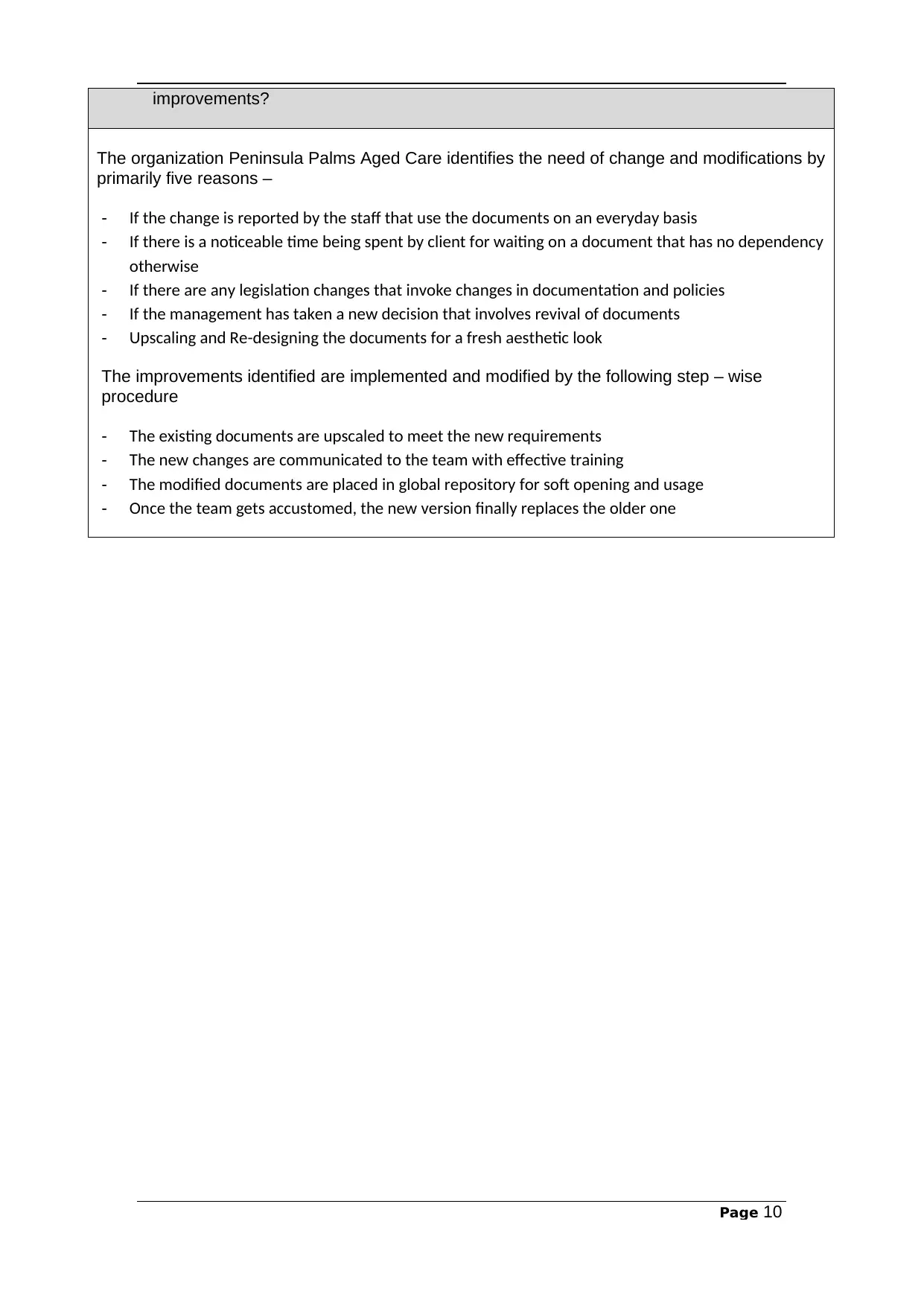
Page 10
improvements?
The organization Peninsula Palms Aged Care identifies the need of change and modifications by
primarily five reasons –
- If the change is reported by the staff that use the documents on an everyday basis
- If there is a noticeable time being spent by client for waiting on a document that has no dependency
otherwise
- If there are any legislation changes that invoke changes in documentation and policies
- If the management has taken a new decision that involves revival of documents
- Upscaling and Re-designing the documents for a fresh aesthetic look
The improvements identified are implemented and modified by the following step – wise
procedure
- The existing documents are upscaled to meet the new requirements
- The new changes are communicated to the team with effective training
- The modified documents are placed in global repository for soft opening and usage
- Once the team gets accustomed, the new version finally replaces the older one
improvements?
The organization Peninsula Palms Aged Care identifies the need of change and modifications by
primarily five reasons –
- If the change is reported by the staff that use the documents on an everyday basis
- If there is a noticeable time being spent by client for waiting on a document that has no dependency
otherwise
- If there are any legislation changes that invoke changes in documentation and policies
- If the management has taken a new decision that involves revival of documents
- Upscaling and Re-designing the documents for a fresh aesthetic look
The improvements identified are implemented and modified by the following step – wise
procedure
- The existing documents are upscaled to meet the new requirements
- The new changes are communicated to the team with effective training
- The modified documents are placed in global repository for soft opening and usage
- Once the team gets accustomed, the new version finally replaces the older one
Paraphrase This Document
Need a fresh take? Get an instant paraphrase of this document with our AI Paraphraser
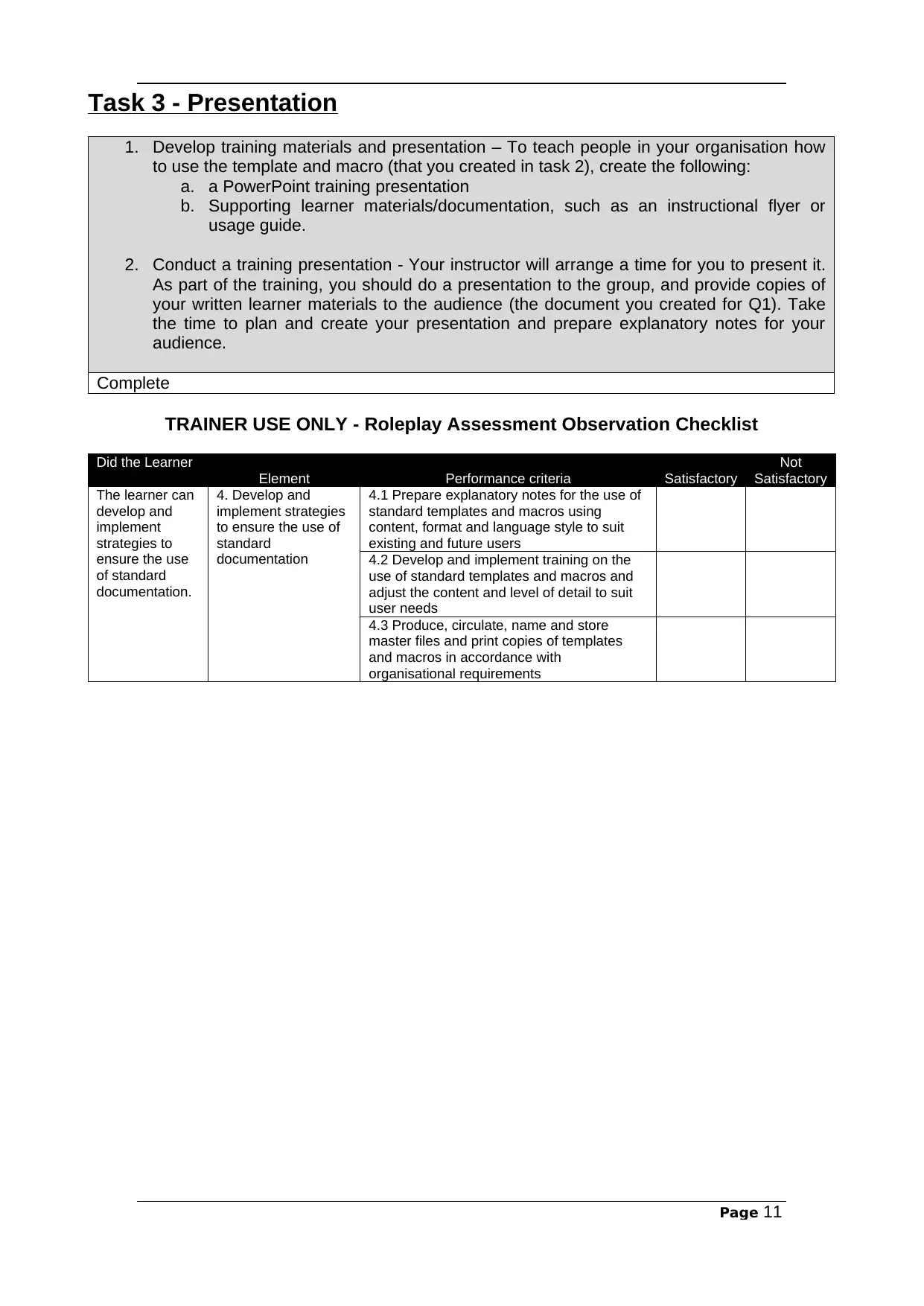
Page 11
Task 3 - Presentation
1. Develop training materials and presentation – To teach people in your organisation how
to use the template and macro (that you created in task 2), create the following:
a. a PowerPoint training presentation
b. Supporting learner materials/documentation, such as an instructional flyer or
usage guide.
2. Conduct a training presentation - Your instructor will arrange a time for you to present it.
As part of the training, you should do a presentation to the group, and provide copies of
your written learner materials to the audience (the document you created for Q1). Take
the time to plan and create your presentation and prepare explanatory notes for your
audience.
Complete
TRAINER USE ONLY - Roleplay Assessment Observation Checklist
Did the Learner
Element Performance criteria Satisfactory
Not
Satisfactory
The learner can
develop and
implement
strategies to
ensure the use
of standard
documentation.
4. Develop and
implement strategies
to ensure the use of
standard
documentation
4.1 Prepare explanatory notes for the use of
standard templates and macros using
content, format and language style to suit
existing and future users
4.2 Develop and implement training on the
use of standard templates and macros and
adjust the content and level of detail to suit
user needs
4.3 Produce, circulate, name and store
master files and print copies of templates
and macros in accordance with
organisational requirements
Task 3 - Presentation
1. Develop training materials and presentation – To teach people in your organisation how
to use the template and macro (that you created in task 2), create the following:
a. a PowerPoint training presentation
b. Supporting learner materials/documentation, such as an instructional flyer or
usage guide.
2. Conduct a training presentation - Your instructor will arrange a time for you to present it.
As part of the training, you should do a presentation to the group, and provide copies of
your written learner materials to the audience (the document you created for Q1). Take
the time to plan and create your presentation and prepare explanatory notes for your
audience.
Complete
TRAINER USE ONLY - Roleplay Assessment Observation Checklist
Did the Learner
Element Performance criteria Satisfactory
Not
Satisfactory
The learner can
develop and
implement
strategies to
ensure the use
of standard
documentation.
4. Develop and
implement strategies
to ensure the use of
standard
documentation
4.1 Prepare explanatory notes for the use of
standard templates and macros using
content, format and language style to suit
existing and future users
4.2 Develop and implement training on the
use of standard templates and macros and
adjust the content and level of detail to suit
user needs
4.3 Produce, circulate, name and store
master files and print copies of templates
and macros in accordance with
organisational requirements
1 out of 11
Related Documents
Your All-in-One AI-Powered Toolkit for Academic Success.
+13062052269
info@desklib.com
Available 24*7 on WhatsApp / Email
![[object Object]](/_next/static/media/star-bottom.7253800d.svg)
Unlock your academic potential
Copyright © 2020–2025 A2Z Services. All Rights Reserved. Developed and managed by ZUCOL.





